Monero Price Analysis - Protocol upgrades and consensus algorithm changes by Josh Olszewicz
Fundamentals suggest that network usage of XMR is currently on the decline, but protocol upgrades and consensus algorithm changes bring XMR to the forefront of the privacy coin arms race.
Monero (XMR) is currently down 79% from the all-time high established on December 20th, 2017. The market cap currently stands at US$1.75 billion, with US$12.35 million in trading volume over the past 24 hours.
XMR is classified as a privacy coin with untraceable, unlinkable, private, and analysis resistant transactions. XMR achieves these privacy features through the use of Multilayered Linkable Spontaneous Anonymous Group (MLSAG) signatures, ring confidential transactions (RCT), and stealth addresses.
MLSAG signatures are used by Shen Noether's RCT, and are based upon Gregory Maxwell's Confidential Transactions and Nicolas van Saberhagen's Ring Signatures. Ring signatures allow any member of a group can produce a signature on behalf of the group, without revealing the individual signer's identity.
RCT improves upon ring signatures by allowing hidden transaction amounts, origins, and destinations with reasonable efficiency and verifiably trustless coin generation. RCT was implemented on XMR in January 2017 and made mandatory in September 2017.
XMR also has a stealth address feature, which are single-use addresses where only the sender and receiver can determine where a payment was sent. After a hard fork in April 2018, XMR also implemented the possibility of multi-sig wallets for joint ownership.
XMR-related protocols also include Tari and Kovri. Tari, announced in May 2018, will introduce token creation, similar to Colored Coins on Bitcoin, ERC20 tokens on Ethereum, and non-fungible tokens (NFTs) in general. Kovri has features that are similar to Tor, and is currently in pre-alpha. Kovri will add additional user privacy by anonymizing geographical location and IP addresses with an overlay network. Initially, Kovri will be implemented in the official XMR wallet. Eventually, all future transactions will be routed through Kovri.
XMR's privacy features have also attracted creators of unwanted mining malware and ransomware. In response, the XMR community created a website to help users affected by these problems, including how to diagnose and remove the malicious software.
Other coins with the option of private transactions include Zcash (ZEC) and Ethereum (ETH) which offer private or confidential transactions if needed through the use of Zero-Knowledge Proofs. DASH (DASH) uses a PrivateSend feature which anonymizes transactions through CoinJoin, a process similar to batching. PIVX (PIVX), a DASH fork, implemented the ZeroCoin protocol late last year and also uses Zero-Knowledge proofs to achieve private transactions.
Among all privacy-related coins, XMR had been consistently leading the pack in regards to transaction fees (green, chart below). On October 18th, XMR completed a hard fork to implement Bulletproofs, which reduced transaction size by 80% and brought transaction fees down to below US$0.03. XMR transaction fees remain higher than ZEC, which does not offer equally robust privacy features.
Transactions per day (line, chart below) are currently sitting near yearly lows, around 3,600, having declined since January. Daily active addresses (fill, chart below) have declined since May but have largely been trendless since mid-2017. Because the transaction data on the XMR blockchain is private, an NVT cannot be calculated.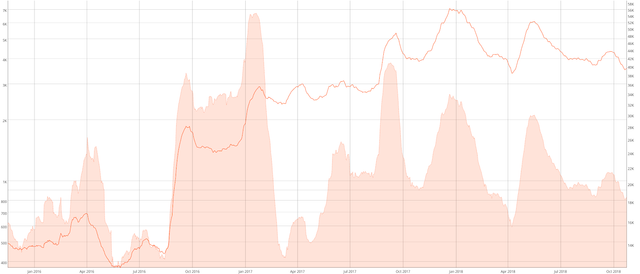
Source: CoinMetrics.io
Beginning in late 2017, XMR's hash rate began to increase substantially, suggestive of stealth ASIC mining. XMR uses a proof-of-work (PoW) consensus algorithm, CryptoNight, which had been application specific integrated circuit (ASIC) resistant for many years. This meant that CPUs and GPUs were advantageous for mining. The use of ASICs can mean increased network centralization because less efficient hardware becomes unprofitable to use, allowing those with more resources to buy more ASICs.
In response, the XMR team announced an emergency hard fork to change the PoW algorithm and stop any ASICs that were currently mining XMR. The team plans to hard fork every six months, changing the PoW algorithm each time, and preventing ASIC use indefinitely. Ideally, it's easier to change a PoW algorithm than rework, build, and ship ASICs. The hard fork in April and the hard fork last week dropped both the hashrate and difficulty substantially.
Source: bitinfocharts.com
Turning to developer activity, the main repo for the XMR project on GitHub has had a cumulative 23 commits over the past 90 days and 1,185 commits over the past year. Most coins use the developer community of GitHub, which was acquired by Microsoft for US$7.5 billion. Files are saved in folders called "repositories," or "repos," and changes to these files are recorded with "commits," which save a record of what changes were made, when, and by who. Although commits represent quantity and not necessarily quality, a higher number of commits can signify higher dev activity and interest.

Exchange traded volume has been led by the Bitcoin (BTC) pair, Tether (USDT), and the U.S. Dollar (USD) pairs. The dominance of the BTC trading pair is largely due to the lack of direct fiat gateways for XMR. The majority of trading has occurred on Bithumb, HitBTC, and Binance.
As exchange services like Shapeshift and Changelly require customers to register for KYC/AML requirements, XMR volume in decentralized exchanges (DEXs) will likely continue to increase. The XMR/BTC pair on Bisq, a peer to peer private DEX, currently accounts for 96% of the total exchange volume.
The Japanese and U.S. governments have expressed interest in "legislative or regulatory actions" to prevent the use of privacy focused cryptocurrencies, such as XMR and ZEC, for illicit purposes. While minimal exchange exposure decreases speculation potential, threats of banning the trading of XMR suggests a strong use case for a specific privacy purpose, which may increase XMR's value. In the future, XMR may be delisted from centralized exchanges and relegated to DEXs entirely. Although, in August, XMR was listed as a potential addition for Coinbase custody.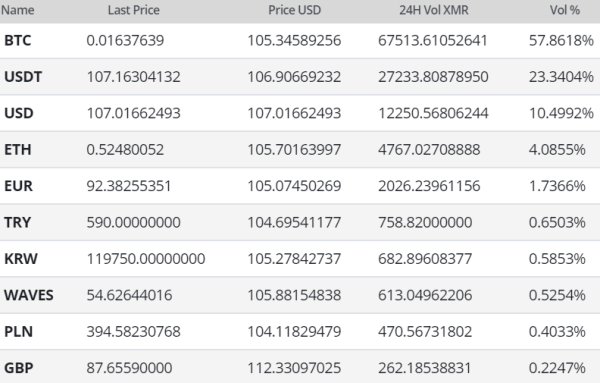
Google Trends for the term "monero" remain down sharply over the course of the year and are sitting at a yearly low. A slow rise in searches for "monero" preceded the bull run in Q4 2017, likely signaling a large swath of new market participants at that time. A 2015 study found a strong correlation between the google trends data and bitcoin price. A May 2017 study concluded that when the U.S. Google "bitcoin" searches increase dramatically, bitcoin price drops.
Technical Analysis
XMR has had a choppy past few months while holding above the psychological support of US$100. When price remains sideways for an extended period of time, a trend reversal becomes more and more likely. Reversals in trend are best found with exponential moving averages (EMAs), chart patterns, and Ichimoku Cloud. Further background information on the technical analysis discussed below can be found here.
The 50/200EMAs on the daily chart have been bearishly crossed for 156 days, resulting in a steady decline of over 60%. This bearish Death Cross and the opposing bullish Golden Cross are significant events for many traders and dictate the direction of the trend going forward. The previous Golden Cross in May never quite materialized into a bull trend. Although the EMA cross is bearish, the 200EMA will act as a mean reversion level for price, currently at US$138.
There is also a building bullish reversal pattern, the diamond bottom, which carries a measured move and 1.618 fib extension of US$185 and US$200. A pause in the move North is likely near the US$155 zone based on previous horizontal support and resistance. The hallmark of this pattern is wild volatility in a diamond shape with descending volume as the pattern is forming. Although this pattern does not have descending volume from beginning to end, the latter half of the diamond has experienced a stepwise decline in volume. As price moves out of the triangle, volume should increase substantially as buyers step in and the pattern resolves.
Further, long/short open interest is net short and near record highs on Bitfinex, with both long and short positions at elevated levels. A significant price movement in either direction will likely be exaggerated as these positions begin to unwind. There are no active RSI or volume divergences. RSI continues to trend below 50, suggesting momentum continues to lean bearish.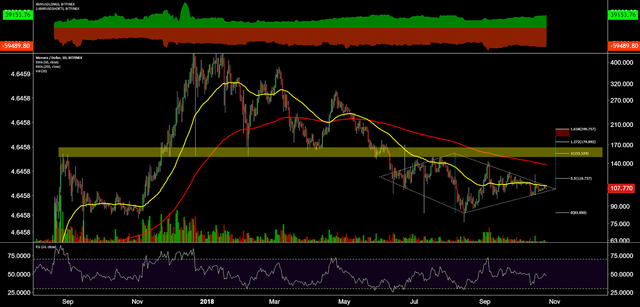
Turning to the Ichimoku Cloud, four metrics are used to determine if a trend exists; the current price in relation to the Cloud, the color of the Cloud (red for bearish, green for bullish), the Tenkan (T) and Kijun (K) cross, and the Lagging Span. The best entry always occurs when most of the signals flip from bearish to bullish, or vice versa.
The status of the current Cloud metrics on the two-day time frame with doubled settings (20/60/120/30) for more accurate signals are leaning bearish; price is below Cloud, Cloud is bearish, TK cross is recently bullish, and Lagging Span is below price and in Cloud. A traditional long entry will not trigger until price is above the Cloud.
However, If price breaks both the Kijun and Cloud resistance, a buy signal or long entry is triggered. The target for this trade would be the top edge of the Cloud, US$228. This trade setup is known as an Edge-to-Edge (E2E) trade. The long flat Kumo at US$228 should act as a magnet for price and represents 50% retracement of the previous high to low.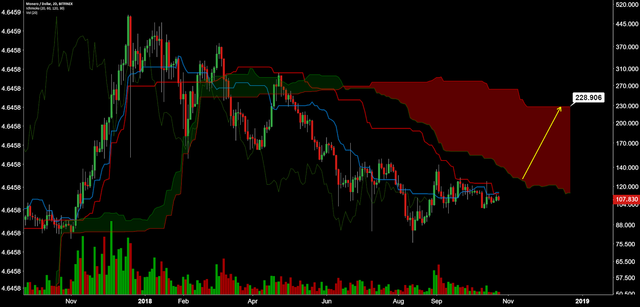
The status of the current Cloud metrics on the daily time frame with doubled settings (20/60/120/30) for more accurate signals are leaning bearish; price is below Cloud, Cloud is recently bullish, TK cross is bearish, and Lagging Span is below price and in Cloud. Again, a traditional long entry will not trigger until price is above the Cloud. The Kumo twist on November 20th establishes a high probability zone for a bullish break above the Cloud, should the momentum exist to do so.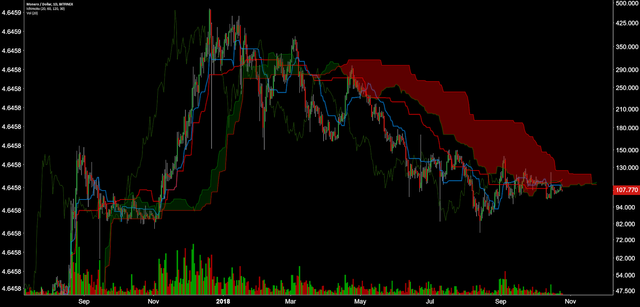
Lastly, on the two-day XMR/BTC pair, price is also bearish based on Cloud metrics. However, the volume profile of the visible range and potential E2E setup on the Cloud suggest a reversal towards 0.02376BTC. Historically, there is very little resistance above 0.01858BTC. XMR/BTC open interest on Bitfinex (not shown) is significantly smaller than the XMR/USD pair and leans heavily long, accounting for 88% of total margin positions.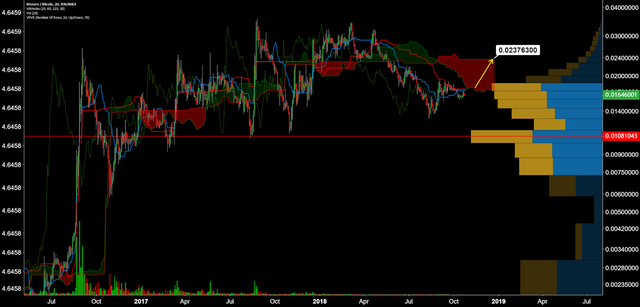
Conclusion
Fundamentals suggest that network usage of XMR is currently on the decline, but protocol upgrades and consensus algorithm changes bring XMR to the forefront of the privacy coin arms race. There is a lingering concern that although hard forks keep XMR ASIC resistant, frequent hard forks introduce a form of centralization on the network, requiring miners, nodes, and wallets to constantly upgrade their software. XMR is the only coin to aggressively combat ASICs in this way but other coins, like SIA, have also chosen this path. A competing privacy coin, ZEC, has decided against this route.
Technicals suggest a strong possibility of trend reversal within the next month. A diamond bottom chart pattern, Cloud, and historical horizontal support/resistance suggest targets of US$200-US$230 with a pitstop and reaccumulation around US$155. Price will likely have substantial buy volume within the next two weeks to complete the diamond bottom pattern.


Great analysis. I'm very keen on Monero right now. The Monero V fork seemed a bit toxic earlier this year but I feel the price is due for a recovery soon.